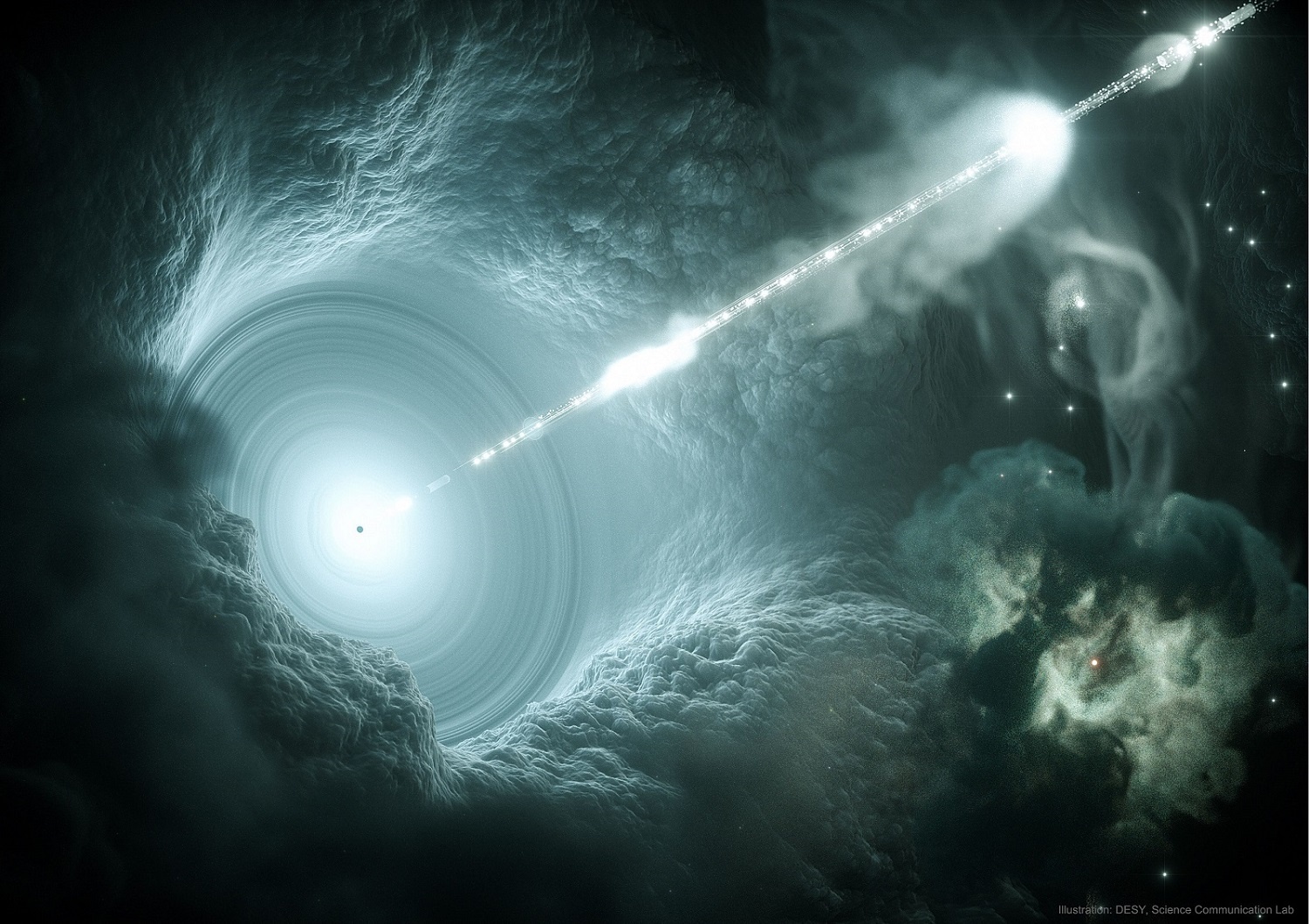Although radio astronomy has been around since the 1930s, it is only in recent years that astronomers have been able to make high-resolution maps of the radio sky. Sky maps are difficult for radio telescopes because radio antennas need to be focused on an extremely small patch of sky to capture images in high resolution. But with modern antennas and computer processing, we can now scan the sky quickly enough to map the heavens in a reasonable amount of time.
Continue reading “Australian Radio Telescopes Just Completed a map of the Universe”New jets seen blasting out of the center of a galaxy
Giant black holes can launch jets that extend for tens of thousand of light-years, blasting clean out of their host galaxies. These jets can last for tens of millions of years. Recently astronomers have spotted the first-ever jet in the process of forming, creating a cavity in the span of only twenty years.
Continue reading “New jets seen blasting out of the center of a galaxy”Speca – An Intriguing Look Into The Beginning Of A Black Hole Jet
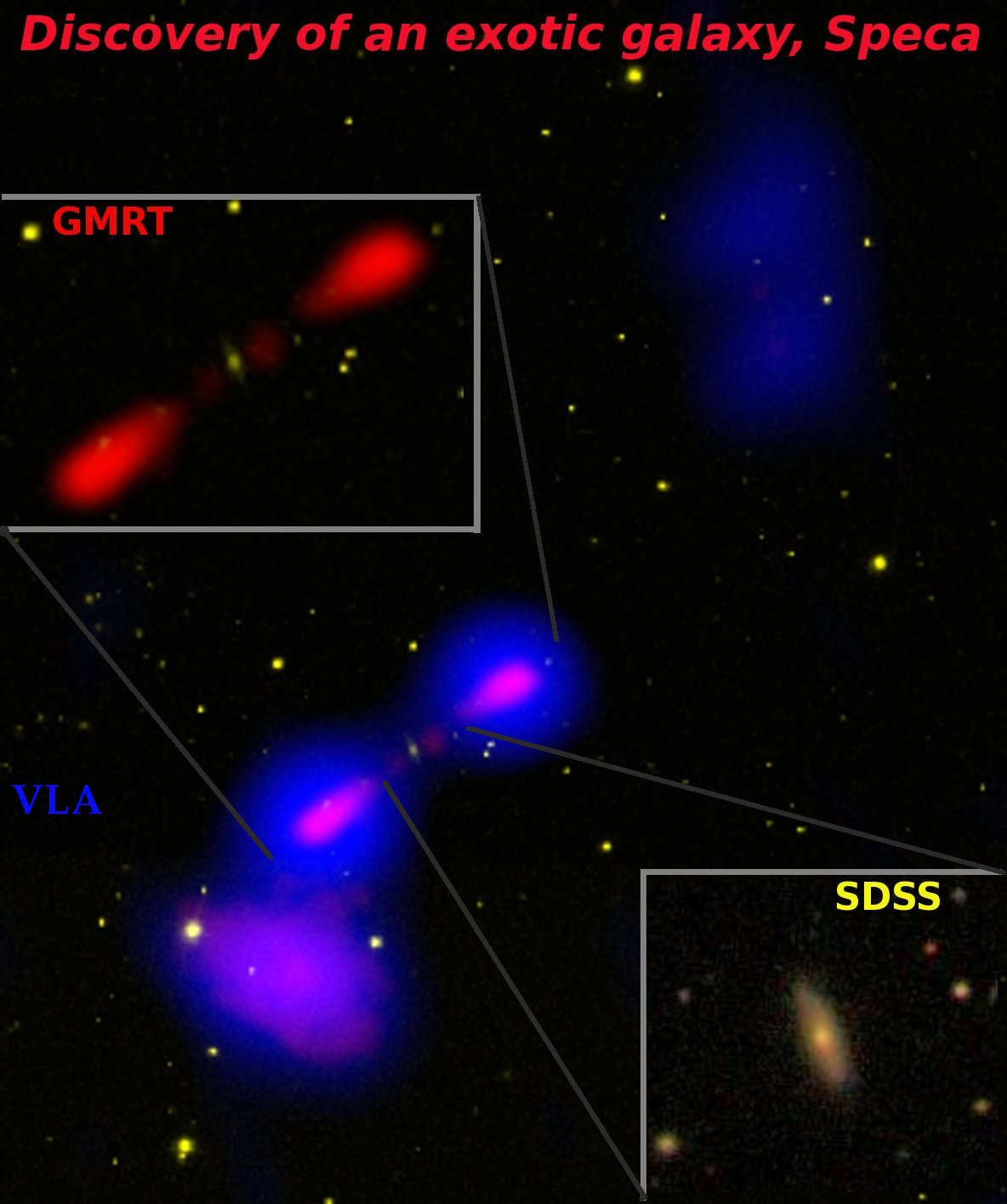
[/caption]
Its name is SPECA – a Spiral-host Episodic radio galaxy tracing Cluster Accretion. That’s certainly a mouthful of words for this unusual galaxy, but there’s a lot more going on here than just its name. “This is probably the most exotic galaxy with a black hole, ever seen. It is like a ‘missing-link’ between present day and past galaxies. It has the potential to teach us new lessons about how galaxies and clusters of galaxies formed in the early Universe,” said Ananda Hota, of the Academia Sinica Institute of Astronomy and Astrophysics (ASIAA), in Taiwan and who discovered this exotic galaxy.
Located about 1.7 billion light-years from Earth, Speca is a radio source that contains a central supermassive black hole. As we have learned, galaxies of this type produce relativistic “jets” which are responsible for being bright at the radio frequencies, but that’s not all they create. While radio galaxies are generally elliptical, Speca is a spiral – reason behind is really unclear. As the relativistic jets surge with time, they create lobes of sub-atomic material at the outer edges which fan out as the material slows down… and Speca is one of only two galaxies so far discovered to show this type of recurrent jet activity. Normally it occurs once – and rarely twice – but here it has happened three times! We are looking at a unique opportunity to unravel the mysteries of the beginning phase of a black hole jet.
“Both elliptical and spiral galaxies have black holes, but Speca and another galaxy have been seen to produce large jets. It is also one of only two galaxies to show that such activity occurred in three separate episodes.” explains Sandeep Sirothia of NCRA-TIFR. “The reason behind this on-off activity of the black hole to produce jets is unknown. Such activities have not been reported earlier in spiral galaxies, which makes this new galaxy unique. It will help us learn new theories or change existing ones. We are now following the object and trying to analyse the activities.”
Dr. Hota and an international team of scientists reached their first conclusions while studying combined data from the visible-light Sloan Digital Sky Survey (SDSS) and the FIRST survey done with the Very Large Array (VLA) radio telescope. Here they discovered an unusually high rate of star formation where there should be none and they then confirmed their findings with ultraviolet data from NASA’s GALEX space telescope. Then the team dug even deeper with radio information obtained from the NRAO VLA Sky Survey (NVSS). At several hundred million years old, these outer lobes should be beyond their reproductive years… Yet, that wasn’t all. GMRT images displayed yet another, tiny lobe located just outside the stars at the edge of Speca in plasma that is just a few million years old.
“We think these old, relic lobes have been ‘re-lighted’ by shock waves from rapidly-moving material falling into the cluster of galaxies as the cluster continues to accrete matter,” said Ananda. “All these phenomena combined in one galaxy make Speca and its neighbours a valuable laboratory for studying how galaxies and clusters evolved billions of years ago.”
As you watch the above galaxy merger simulation created by Tiziana Di Matteo, Volker Springel, and Lars Hernquist, you are taking part in a visualization of two galaxies combining which both have central supermassive black holes and the gas distribution only. As they merge, you time travel over two billion years where the brightest hues indicate density while color denotes temperature. Such explosive process for the loss of gas is needed to understand how two colliding star-forming spiral galaxies can create an elliptical galaxy… a galaxy left with no fuel for future star formation. Outflow from the supernovae and central monster blackholes are the prime drivers of this galaxy evolution.
“Similarly, superfast jets from black holes are supposed to remove a large fraction of gas from a galaxy and stop further star formation. If the galaxy is gas-rich in the central region, and as the jet direction changes with time, it can have an adverse effect on the star formation history of a galaxy. Speca may have once been part of such a scenario. Where multiple jets have kicked out spiral arms from the galaxy. To understand such a process Dr Hota’s team has recently investigated NGC 3801 which has very young jet in very early-phase of hitting the host galaxy. Dust/PAH, HI and CO emission shows an extremely warped gas disk. HST data clearly showa outflow of heated-gas. This gas loss, as visualised in the video, has possibly caused the decline of star formation. However, the biggest blow from the monster’s jets are about to give the knock-down punch the galaxy.
“It seems, we observe this galaxy at a rare stage of its evolutionary sequence where post-merger star formation has already declined and new powerful jet feedback is about to affect the gaseous star forming outer disk within the next 10 million years to further transform it into a red-and-dead early-type galaxy.” Dr. Hota says.
The causes behind why present day radio galaxies do not contain a young star forming disks are not clear. Speca and NGC 3801 are ideal laboratories to understand black hole galaxy co-evolution processes.
Original Research Paper: Caught in the act: A post-merger starforming early-type galaxy with AGN-jet feedback. For Further Reading: Various press releases and news on the discovery of Speca. This article has been changed slightly from its original publication to reflect more information from Dr. Hota.
To The Extreme… NASA’s Fermi Gamma-Ray Telescope Gathers In High Energy
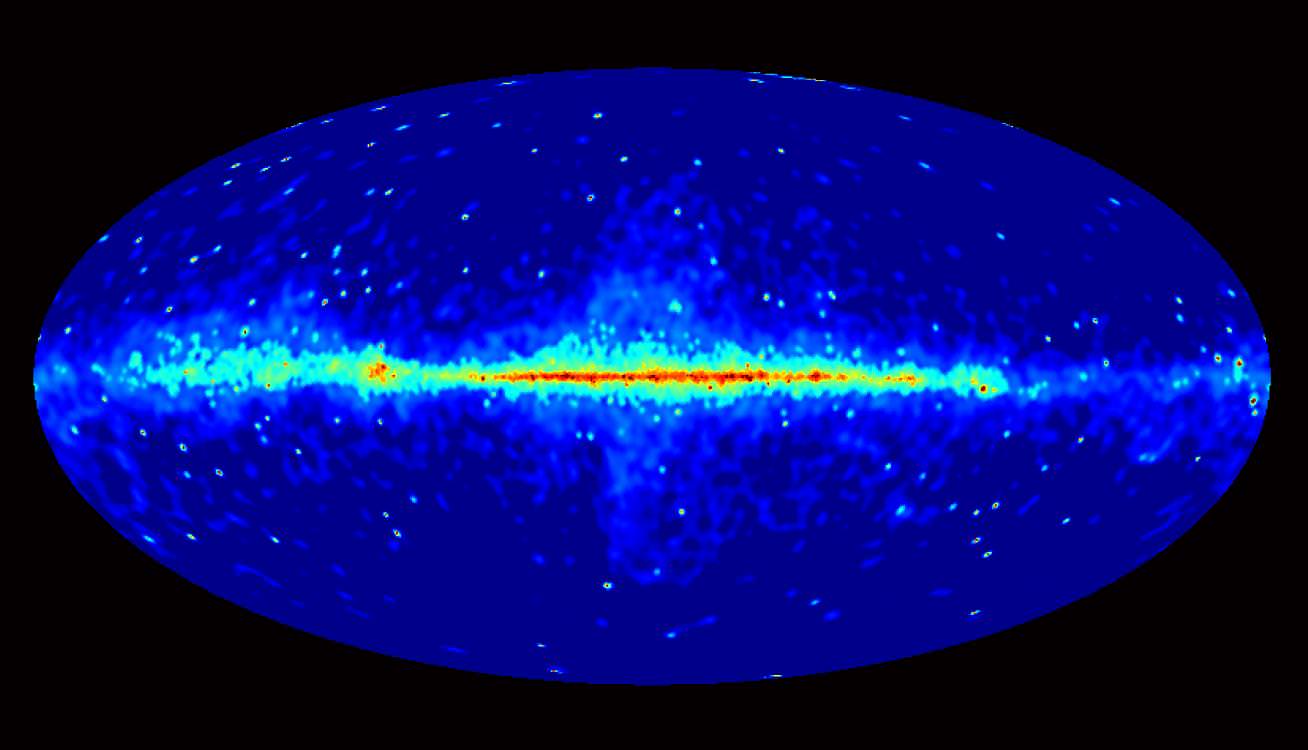
[/caption]
It scans the entire visible sky every three hours. Its job is to gather light – but not just any light. What’s visible to our eyes averages about 2 and 3 electron volts, but NASA’s Fermi Gamma-Ray Space Telescope is taking a deep look into a higher realm… the electromagnetic range. Here the energy doesn’t need a boost. It slams out gamma-rays with energies ranging from 20 million to more than 300 billion electron volts (GeV). After three years of space time, the Fermi Large Area Telescope (LAT) has produced its first census of these extreme energy sources.
Over its current operating time, Fermi has continued to paint an ever-deepening portrait of the gamma-ray sky. Even with the huge amount of data which pours in over its 180 minute window, high energy events are not common. When it comes to sources above 10 GeV, even Fermi’s LAT detects only one source about three times a year.
“Before Fermi, we knew of only four discrete sources above 10 GeV, all of them pulsars,” said David Thompson, an astrophysicist at NASA’s Goddard Space Flight Center in Greenbelt, Md. “With the LAT, we’ve found hundreds, and we’re showing for the first time just how diverse the sky is at these high energies.”
Just what exactly is out there which can produce such a powerful process? When it comes to gamma-rays, more than half of Fermi’s nearly 500 findings are active galaxies where matter falling into their central supermassive black holes produces intense jets spewing out at close to light speed. A small portion – around 10% – of the census belongs to sources within the Milky Way. These are pulsars, supernova debris and a handful of binary systems which house massive stars. What’s really interesting is the portion of totally unidentifiable sources that constitute about a third of the findings. They simply don’t have any spectroscopic counterparts and astronomers are hoping that these higher energy sources will give them new material to compare their findings against.
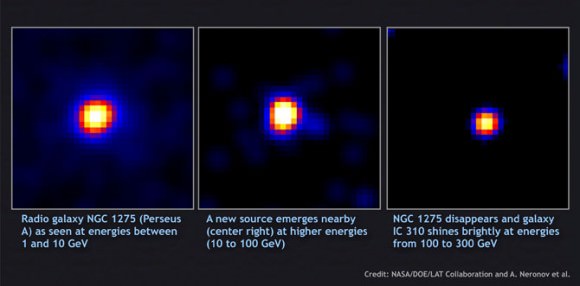
When it comes to light – obey the rules. Just as we understand that sources of infra-red light fade away when viewed in the ultra-violet, gamma-ray sources above 1 GeV can disappear without a trace when viewed at higher, or “harder,” energies. “One example is the well-known radio galaxy NGC 1275, which is a bright, isolated source below 10 GeV.” says the Fermi team. ” At higher energies it fades appreciably and another nearby source begins to appear. Above 100 GeV, NGC 1275 becomes undetectable by Fermi, while the new source, the radio galaxy IC 310, shines brightly.” The Fermi hard-source list is the product of an international team led by Pascal Fortin at the Ecole Polytechnique’s Laboratoire Leprince-Ringuet in Palaiseau, France, and David Paneque at the Max Planck Institute for Physics in Munich.
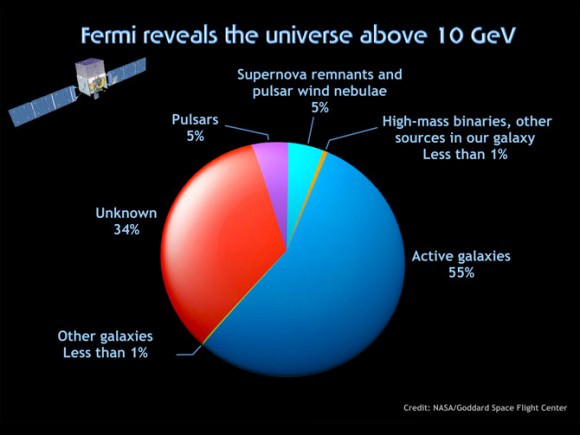
The new Fermi census will be a unique source of comparative information to assist ground-based facilities called Atmospheric Cherenkov Telescopes. These sources have confirmed 130 gamma-ray sources with energies above 100 GeV. They include the Major Atmospheric Gamma Imaging Cherenkov telescope (MAGIC) on La Palma in the Canary Islands, the Very Energetic Radiation Imaging Telescope Array System (VERITAS) in Arizona, and the High Energy Stereoscopic System (H.E.S.S.) in Namibia.
“Our catalog will have a significant impact on ground-based facilities’ work by pointing them to the most likely places to find gamma-ray sources emitting above 100 GeV,” Paneque said.
But big ground-based telescopes have big limitations. In this case, their field of view is very constricted and they can’t operate during daylight hours, full Moon or bad weather. But don’t count them out.
“As Fermi’s exposure constantly improves our view of hard sources, ground-based telescopes are becoming more sensitive to lower-energy gamma rays, allowing us to bridge these two energy regimes,” Fortin added.
Original Story Source: NASA Fermi News Release. For Further Reading: Major Atmospheric Gamma Imaging Cherenkov telescope (MAGIC) on La Palma in the Canary Islands, Very Energetic Radiation Imaging Telescope Array System (VERITAS) in Arizona and High Energy Stereoscopic System (H.E.S.S.) in Namibia. For Further Images: Fermi Images.


